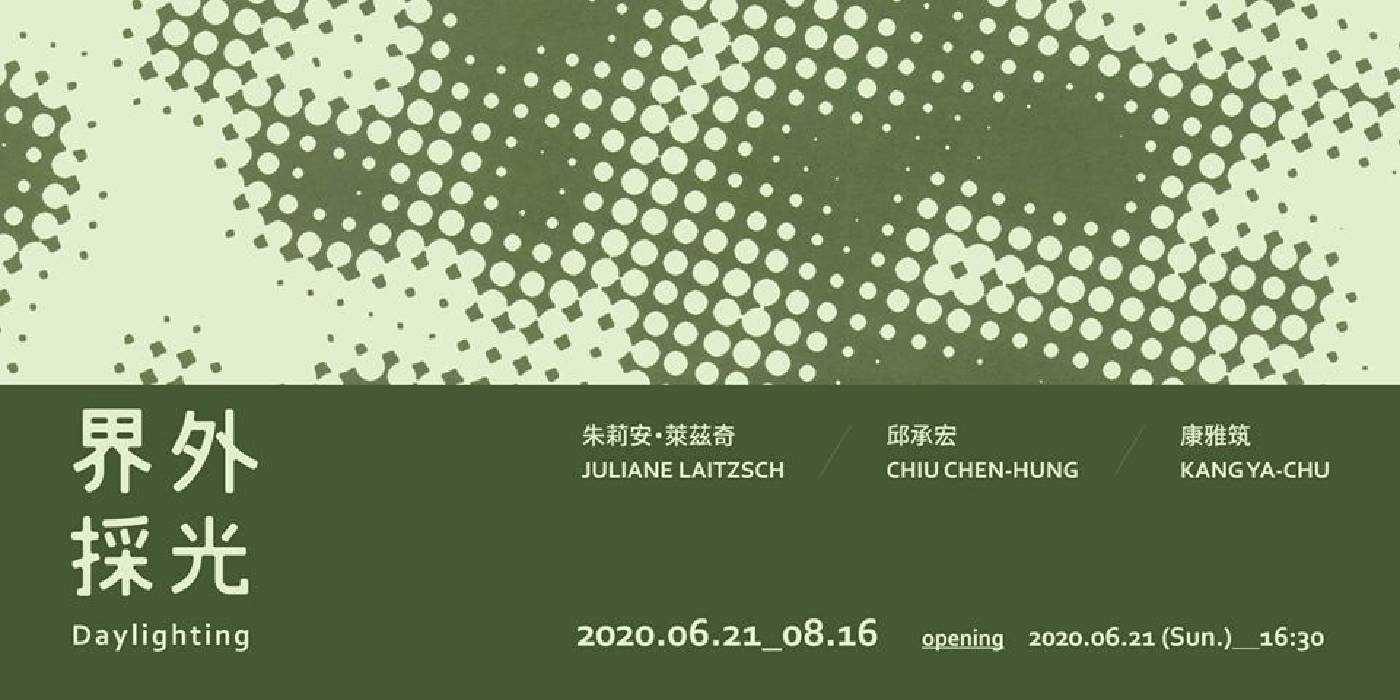本事藝術
【界外採光】Daylighting

-
展期
日期:2020-06-21 ~ 2020-08-16
-
地點
中正路1112號
-
參展藝術家
朱莉安・萊茲奇 Juliane Laitzsch、邱承宏 Chiu Chen-Hung、康雅筑 Kang Ya-Chu
-
“Daylighting” 除了直譯為「採光」之外的另類意涵,係指將因工業革命和都市化後,
被地下化、人工化的的河流重新開挖,讓河流得以重現。在本展中,「採光」作為挖掘歷史與記憶的隱喻,挖掘的對象是落於主流史觀之外,乘載著微觀、日常,或是關於他者的支流。
展出的藝術家同樣具有雕塑的學習背景,卻分別採用繪畫、雕刻與纖維創作的相異方法,將撿拾的幽微殘片在不同時空維度間往復、轉化,堆砌出由材質與記憶交織的場域。其中有地緣政治的越界,有重組虛實的意圖,也有對現行系統的批判質疑,而看似平滑的表面背後,帶有個人想像的、非知識生產性的伏流湧現,或匯聚、或擴張地使固態的邊界模糊,從而溢出一種浪漫主義般的獨特史詩感。
雕塑背景出身的朱莉安・萊茲奇,長年來以素描為主要創作型態,作品兼具精準的科學觀察與游移的詩意想像,如鐘擺一般探索介於研究、敘事形式與物件等種種關於「之間」的空間。此次展出的〈Close Up〉系列為藝術家進行長達十多年來的歷史織品結構研究的進行式,針對德國Magdeburg博物館收藏的埃及近古織品碎片展開繁複的考究,並以檔案、出版與展覽陳列等傳遞媒介中的圖像作為描繪主體,從中揭露文化遺跡的幽微暗面。〈Rosettes and Trees of Life〉系列則是受到科學家的合作對話啟發,將十九世紀的刺繡樣本圖騰與人類脊椎骨的生長樣態對照,猶如理性研究與懷舊生活的相接,在空間中燦爛繽紛地蔓生。
邱承宏的創作多以裝置、雕塑的方式呈現,如同考古探險般,他善於挖掘生存時空曾經存在的身影與軌跡,將之生動地重塑,藉此發展出一套巨大的記憶修補術。此次展出回應畫廊二樓展間的全新系列〈採光〉,發想自散落台灣各處的舊時軍事碉堡,將碉堡望出的窗景及植物的影子雕鑿在由混凝土及礦物製成的面板。而在〈花架〉中,滋長中的活體植物揉合歷史邊緣拖曳出的陰影,重組了另一種感知意識及時間、地點之間的聯繫,亦顯露出藝術家在面對充滿災難及極端變化的時代,藉由作品的形式與空間佈局,重新梳理原本對立的邊界的企圖。
康雅筑的藝術研究以紡織文化史和當代社會行為表象為基礎,研究不同文化之間的相異與連結,並從材料本身的歷史意涵出發,探討現代性如何影響傳統、經濟系統與自然環境。展出作品包含繪畫、雕塑與裝置,呈現於芬蘭、挪威、印度與台灣的探查之旅的採集成果,各式的纖維材料作為織物歷史與當代生活樣態的雙引線,探討人類生存與自然界緊密相連又彼此衝突的關係。在此,編織作為一種雜揉記憶與想像、過去與未來的結構創造,透過身體的勞動將時間編輯成空間,除呈現其中的穿越、擴張、缺空,更有修補、修復的積極意涵—誠如藝術家所言,編織是為了消除邊界,建立連結並鼓勵對話。
Daylighting
Other than its literal meaning —— the practice of directing natural sunlight into indoor spaces, the word “Daylighting” can be alternatively interpreted as the process of re-excavating the man-made subterranean rivers caused by the Industrial Revolution and urbanization so as to bring the rivers to light again. For this exhibition, “Daylighting” is given a metaphorical meaning as the excavation of memory and history, aiming to discover a diverse range of side streams containing the micro view of daily particularities or the notion of otherness that are deemed to fall outside mainstream historical view.
Despite all the participating artists have formal training in sculpture, they use their respective approaches in terms of drawing, sculpture, and textile to transform the discovered fragments, and make them reciprocate between different space-time notions, thus building up the fields that interweave materials and memories. Among these practices, issues have been raised regarding the boundary crossing in geopolitics, the aim of reconstructing solid-void relationships, as well as the critical question about current systems. However, behind the appearance of smooth flow there is a distinctive, imaginative and non-intellectual process resulting in undercurrents that spring up, converge, or even expand for blurring the fixed boundaries, thus triggering an exceptional sense of romanticism-like, epic wonder.
Juliane Laitzsch, who had received formal training in sculpture, has worked primarily in drawing for years. Her practices embody both precise scientific observation and wandering, poetic imagination, attempting to explore the scenarios of “in-between” spaces amongst researches, narratives, and objects, just like a swinging clock pendulum. The exhibiting series Close Up reflects Laitzsch’s ongoing research on the structural design of historic textiles spanning more than a decade, and she had conducted a particularly detailed study of the fabric fragments from Late Antique Egypt collected by the Museum of Cultural History Magdeburg. Accordingly, the themes for the drawings mostly refer to the images found in a variety of media such as archive, publication, and exhibition, thus revealing the subtle mystery of cultural relics; Rosettes and Trees of Life series was inspired by the collaborative dialogues between scientists. With texts concerning the development of vertebrae in the human spine shown in a corresponding manner to the embroidery sampler patterns from the 19th century, these drawings become the fertile fields that allow rational researches meet nostalgic lives, sprawling across the exhibition space, flourishingly and splendidly.
Chiu Chen-Hung works primarily in installation and sculpture. Like conducting an archaeological excavation, Chiu specializes in uncovering the physical traces and remnants of bygone days which are vividly transformed through his artistic practice, thus developing a vast memory restoration. "Daylighting" is a series of new work made in response to the space on the second floor of the gallery, of which concept is derived from the old military fortifications scattered throughout Taiwan. Accordingly, this work portrays the window views from fortifications and the shadows of plants by carving their silhouettes on a board made of concrete and minerals while the Mikania Micrantha, a commonly seen species of invasive alien weeds, is placed on the shelf-like "Plant Stands". Hence, the vigorously growing plants interwoven with the trailing shadows stemming from the fringe of history have formed a new kind of perceptual experience as well as connection between time and place; also, the visual presentation and spatial arrangement of the displaying works mirror Chiu’s intention to reconstruct the boundaries that appear to be antagonistic in the first place as he copes with the catastrophic challenges and ever-changing worlds.
Kang Ya-Chu conducts her artistic practice and research based on the cultural history of textiles and the appearance of contemporary social behavior, focusing on the differences and connections among various cultures. Also, her practices often start with the historical meaning of materials per se, discussing how modernity has impacted tradition, economic systems and natural environment. The paintings, sculptures, and installations shown in “Daylighting” respond to the results obtained from the field researches Kang had conducted in Finland, Norway, India and Taiwan. Acting as the versatile leads that mark both the history of textiles and contemporary lifestyle, these fiber materials explore the tight linkage and conflicts between human exitance and nature. Here, the act of weaving functions as a creative construction process of intertwining memory and imagination as well as the past and the future; in a sense, time has been converted into a spatial scale through such physical work, so as to suggest not merely the transcendence, expansion and vacancy involved, but also a more positive meaning as repair or restoration —— Just like what Kang has said, “To weave is to eliminate boundaries, build connections and encourage dialogues”.
